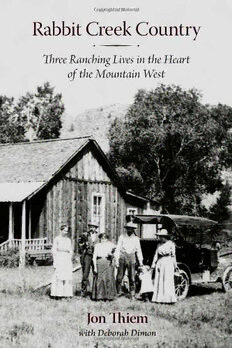
Rabbit Creek Country: Three Ranching Lives in the Heart of the Mountain West PDF
469 Pages·2008·4.116 MB·English
Most books are stored in the elastic cloud where traffic is expensive. For this reason, we have a limit on daily download.
Preview Rabbit Creek Country: Three Ranching Lives in the Heart of the Mountain West
Description:
In 1997 Jon Thiem was hiking in Livermore country near Fort Collins, Colorado. Following one fork of Rabbit Creek, he discovered an abandoned house and literally walked into the lives of John and Ida Elliott and Miss Josephine Lamb. Always curious about earlier inhabitants of this land, and conscious of the changes wrought by modern sprawl on its use and character, Thiem pursued the story of these former ranchers for nearly a decade.What Thiem and research associate Deborah Dimon discovered is that the three had an unconventional living arrangement that endured for over forty years, a relationship that had as much to do with their love of the land as of each other.John Elliott's father moved his growing family from Iowa to Kansas in the 1880s, then to northern Colorado in 1890 when John was twelve. He worked as a ranch hand and eventually became one of the biggest landowners in the area.Ida Meyer ventured west from Nebraska in 1897. A serious amateur photographer, she worked as a waitress, and pie lady, at the local hotel until she was in her early thirties. She and John finally tied the knot in 1908, and in 1910 he bought a thousand acres on Middle Rabbit Creek. Josephine Lamb grew up in the country west of Fort Collins. Graduating from high school in 1916, she became a mountain teacher, traveling to small remote schools. Miss Lamb moved to the Elliott's ranch in 1919 to teach their only child, Buck, until he left for high school. She lived at Rabbit Creek Ranch, possibly as John Elliott's lover, for many years after that, acquiring her own land as time went by.Tracing the flawed humanity of these three intertwined lives opens a window on life in the mountain West throughout the last century, including ranching methods and women's changing roles as wives, mothers, and property owners.
See more
The list of books you might like
Most books are stored in the elastic cloud where traffic is expensive. For this reason, we have a limit on daily download.
